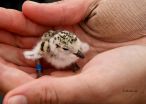Sediment dwelling creatures at risk from nanoparticles in common household products
Researchers from the University of Exeter highlight the risk that engineered nanoparticles released from masonry paint on exterior facades, and consumer products such as zinc oxide cream, could have on aquatic creatures.
2015-08-13
(Press-News.org) Researchers from the University of Exeter highlight the risk that engineered nanoparticles released from masonry paint on exterior facades, and consumer products such as zinc oxide cream, could have on aquatic creatures.
Textiles, paint, sunscreen, cosmetics and food additives are all increasingly containing metal-based nanoparticles that are engineered, rather than found naturally.
The review, published today in the journal Environmental Chemistry, highlights the risks posed to aquatic organisms when nanoparticles 'transform' on contact with water and as they pass from water to sediment and then into sediment dwelling organisms.
Sediments are important for the health of many aquatic ecosystems and are speculated to be a large potential sink for nanoparticles.
Richard Cross, lead author and postgraduate researcher from the College of Life and Environmental Sciences at the University of Exeter's Biosciences department said: "We argue for the need to incorporate the transformations that engineered nanomaterials undergo as they pass from water bodies into sediments, as their form and nature will change as they do so. This is important to consider if we are to improve environmental realism in our experimental efforts and also better understand the long term effects of these materials in the environment."
Professor Charles Tyler, of the College of Life and Environmental Sciences at the University of Exeter, added: "In the aquatic environment, it is known that many nanomaterials will end up in the sediment, so it makes sense to focus on this environmental compartment as a possible worst case scenario for exposures and effects in aquatic systems. This review serves to highlight what we need to consider when assessing the susceptibility of sediment dwelling organisms to nanomaterials."
The study calls for more research into whether 'marine snow' - organic detritus that falls through layers of water - acts as a transport system for nanoparticles and closer examination of bioaccumulation and toxicity in sediment-dwelling species.
The study highlights a large knowledge gap and recommends further research into the factors that determine the fate of nanoparticles in aquatic systems.
INFORMATION:
ELSE PRESS RELEASES FROM THIS DATE:
2015-08-13
Since the chickenpox vaccine became available in the U.S. in 1995, there has been a large reduction in chickenpox cases. Hospitalizations and outpatient visits for chickenpox have continued their decline after a second dose of the vaccine was recommended to improve protection against the disease, according to a new study published in the Journal of the Pediatric Infectious Diseases Society. The findings also suggest that increasing vaccination coverage against the once common childhood illness helps protect those who are not immunized themselves.
Chickenpox, also known ...
2015-08-13
Boston, MA-- A marker commonly used to determine if a patient is having a heart attack can also be used to identify stable patients at high risk for deadly cardiac events, according to a new study led by investigators at Brigham and Women's Hospital (BWH). Using a test that is more sensitive than what is currently used in U.S. hospitals and clinics, the research team found that nearly 40 percent of patients with type 2 diabetes and stable heart disease had abnormal blood levels of the protein troponin. Patients with elevated levels of troponin were twice as likely as ...
2015-08-12
When it comes to reproduction, not every individual equally pulls his or her weight. Dana Herman and Mark Colwell of Humboldt State University spent 13 years tracking the successes and failures of almost 200 individual Snowy Plovers (Charadrius nivosus) nesting at a variety of sites in Humboldt County, California, to identify the factors that could be influencing reproductive success for birds in this threatened population. Their results, published this week in The Condor: Ornithological Applications, show that more than human activity, predator presence, exclosures to ...
2015-08-12
Working in groups is advantageous because different individuals can be responsible for different information, allowing each individual to develop more in-depth expertise. For instance, a plumber, electrician, and carpenter work together to build a house, but each is responsible for unique aspects of the project. This is an example of a transactive memory system: information is distributed across the group, and each group member is aware of what he or she knows, as well as who knows what.
Because the Internet surpasses any person in accessibility, speed, and breadth of ...
2015-08-12
COLUMBIA, Mo. (Aug. 12, 2015) Approximately 60 percent of young people habitually skip breakfast up to four times a week, previous research has shown. Although health experts recommend breakfast as a strategy to reduce an individual's chance of obesity, little research has examined if the actual type of breakfast consumed plays a significant role in one's health and weight management. University of Missouri researchers compared the benefits of consuming a normal-protein breakfast to a high-protein breakfast and found the high-protein breakfast - which contained 35 grams ...
2015-08-12
All freshwater streams and rivers actually release carbon dioxide, but the source of those emissions has for years been unclear to scientists.
Now, researchers have shown that the greenhouse gas appears in streams by way of two different sources -- either as a direct pipeline for groundwater and carbon-rich soils, or from aquatic organisms releasing the gas through respiration and natural decay.
CO2's origins -- land or life -- depend largely on the size of the stream or river, according to a paper published Aug. 10 in Nature Geosciences. These findings shed light ...
2015-08-12
For any computer, being able to manipulate information is essential, but for quantum computing, singling out one data location without influencing any of the surrounding locations is difficult. Now, a team of Penn State physicists has a method for addressing individual neutral atoms without changing surrounding atoms.
"There are a set of things that we have to have to do quantum computing," said David S. Weiss, professor of physics. "We are trying to step down that list and meet the various criteria. Addressability is one step."
Quantum computers are constructed and ...
2015-08-12
Simply put, cancer is caused by mutations to genes within a cell that lead to abnormal cell growth. Finding out what causes that genetic mutation has been the holy grail of medical science for decades. Researchers at the Texas A&M Health Science Center Institute of Biosciences and Technology believe they may have found one of the reasons why these genes mutate and it all has to do with how stem cells talk to each other.
The landmark studies by Texas A&M researchers Fen Wang, Ph.D., and Wallace McKeehan, Ph.D., appear in the Journal of Biological Chemistry and are available ...
2015-08-12
CAMBRIDGE, MA -- Chemists working in a variety of industries and fields typically go through a laborious process to measure and mix reagents for each reaction they perform. And many of the common reagents they use sit for months or years on shelves in laboratories, where they can react with oxygen and water in the atmosphere, rendering them useless.
In a paper published this week in Nature, researchers at MIT describe a technique that could help avoid this costly waste, and greatly reduce the number of steps a chemist must perform to prepare common compounds for use in ...
2015-08-12
Male elephant seals compete fiercely for access to females during the breeding season, and their violent, bloody fights take a toll on both winners and losers. These battles are relatively rare, however, and a new study shows that the males avoid costly fights by learning the distinctive vocal calls of their rivals. When they recognize the call of another male, they know whether to attack or flee depending on the challenger's status in the dominance hierarchy.
Researchers from UC Santa Cruz have been studying the behavior of northern elephant seals at Año Nuevo ...
LAST 30 PRESS RELEASES:
[Press-News.org] Sediment dwelling creatures at risk from nanoparticles in common household products
Researchers from the University of Exeter highlight the risk that engineered nanoparticles released from masonry paint on exterior facades, and consumer products such as zinc oxide cream, could have on aquatic creatures.



